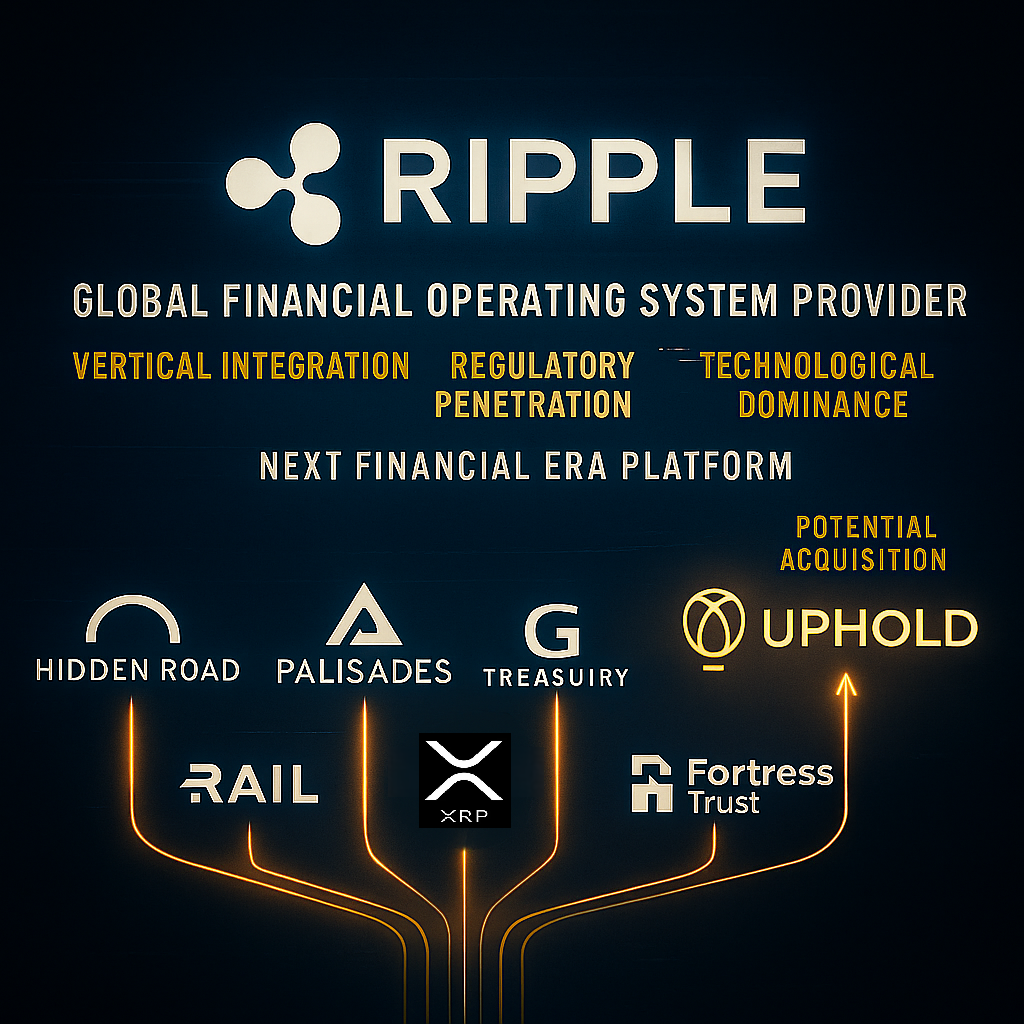Hypothetical Acquisition of Uphold

Ripple’s Bigger Picture:
Overview
If Ripple were to acquire Uphold, the move would signify the completion of one of the most strategically cohesive infrastructures in the modern financial landscape. Ripple has spent the past several years assembling a vertically integrated financial ecosystem: liquidity access, custody infrastructure, treasury management, regulatory presence, and settlement technology. The only missing link — direct retail and institutional exchange access — could be filled perfectly by Uphold.
Why Uphold Makes Strategic Sense
Uphold is not just another crypto exchange. It’s an interoperable multi-asset bridge that allows users to move between fiat currencies, cryptocurrencies, equities, and even precious metals — instantly and seamlessly. Its unique capability to execute “anything-to-anything” transfers (for example, converting Tesla stock directly into XRP or gold) sets it apart from every other platform. This capability mirrors Ripple’s own mission of value interoperability across assets, networks, and borders.
Key differentiators:
- Anything-to-Anything Model: Users can exchange between vastly different asset classes without routing through intermediaries.
- No Withdrawal Fees: Free ACH, SEPA, and FPS transfers reduce friction for users.
- Simplified Interface: Uphold avoids the clutter of advanced trading tools, focusing on accessibility and liquidity routing — much like how Ripple emphasizes utility over speculation.
- XRP Loyalty: Uphold was one of the very few exchanges that refused to delist XRP during the SEC lawsuit, signaling strong philosophical alignment and early trust with Ripple’s community.
Ripple’s Existing Acquisitions: Completing the Loop
Ripple’s recent acquisitions — Metaco, Rail, Hidden Road, Palisade, GTreasury, Fortress Trust — already create an institutional-grade framework that bridges finance and crypto. Each plays a unique role:
- Hidden Road – Liquidity access for institutional clients.
- Metaco & Palisade – Custody solutions (Switzerland & France) enabling regulated storage and management of digital assets.
- GTreasury – Enterprise treasury management integration for corporations.
- Rail – Payment and cash management infrastructure.
- Fortress Trust – U.S. regulatory foothold in trust and compliance services.
Ripple has transformed from a “payments company fighting the SEC” into a global financial operating system provider. With Metaco securing assets, GTreasury embedding corporate connectivity, Hidden Road unlocking institutional liquidity, Palisade managing wallets, and Rail simplifying stablecoin payments, Ripple has achieved:
- Vertical Integration across custody, liquidity, and treasury functions.
- Regulatory Penetration across the U.S., EU, and APAC.
- Technological Dominance via tokenization, stablecoins, and enterprise integration.
When viewed together, Ripple’s ecosystem isn’t just a collection of companies — it’s the architecture of the next financial era.
Adding Uphold would close the loop:
- Retail On/Off Ramp: Gives Ripple direct control over user onboarding, KYC/AML, and fiat-crypto gateways.
- Multi-Asset Exchange: Expands RippleNet’s interoperability into equities and commodities.
- Liquidity Layer: Ties directly into Hidden Road’s institutional liquidity and RLUSD settlement network.
- Regulatory Advantage: Leverages Uphold’s existing licenses in multiple jurisdictions, easing Ripple’s expansion.
Regulatory Implications
Ripple has already applied to become a bank and for a Federal Reserve Master Account via its subsidiary, Standard Custody & Trust Company. With Uphold in its portfolio, Ripple could:
- Integrate exchange operations directly into banking infrastructure.
- Provide customers with insured fiat custody and settlement.
- Create an end-to-end payments and liquidity ecosystem regulated at the federal level.
- Enable instant movement between fiat, tokenized securities, and digital assets — all on the XRP Ledger.
The Bigger Picture
This acquisition would effectively position Ripple as a next-generation financial institution — part bank, part exchange, part settlement network — all operating under unified regulatory clarity. Ripple would no longer just facilitate payments for others; it would own the full transaction stack. Which in turn positions Ripple as the next evolution in payments/remittances infrastructure.
Imagine this closed-loop system:
- Customer Onboarding: Retail or institutional users onboard through Uphold.
- Custody & Compliance: Assets held and managed via Metaco/Palisade/Fortress.
- Liquidity Routing: Trades routed through Hidden Road’s prime brokerage layer.
- Treasury Operations: Corporate liquidity and cash flow managed through GTreasury/Rail integrations.
- Settlement: All final settlements executed on the XRP Ledger, with RLUSD serving as the bridge currency.
The end result — Ripple becomes the operating system for global value exchange, with Uphold serving as the universal user interface.
Closing Thought
If Ripple were to acquire Uphold, it wouldn’t come as a surprise — it would represent the natural progression of Ripple’s transformation from a payments-focused company into a comprehensive financial network. By merging Uphold’s versatile “anything-to-anything” exchange model with Ripple’s infrastructure, the result could be the world’s first multi-asset liquidity network: decentralized in design, yet unified in functionality. With Ripple Prime (via Hidden Road) already positioned to meet increasing customer demand, acquiring Uphold would be a logical step toward addressing that demand in a fully integrated way.

https://anthonytankhall.com/xrps-price-considering-various-metrics/ Check out the various metrics that could enable significant price increase(s) for the XRP Token.